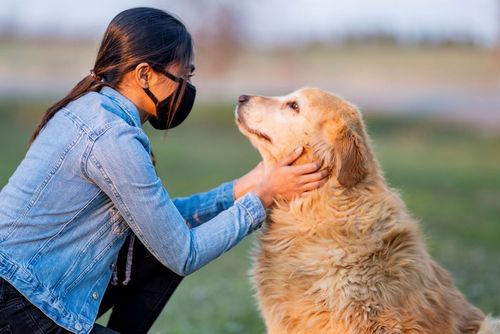–
–
The bat was first pointed out. Then the pangolin. Without being able to prove beyond any doubt how the first or the second would have transmitted SARS-CoV-2, the virus responsible for COVID-19, to our species. Would an intermediate host have acted like a reservoir to allow this infectious agent to adapt to humans? The mystery hovers.
What researchers can say with certainty, however, is that this damn virus is spread primarily from person to person. But it also has zoonotic potential. “At this point in the pandemic, it is humans who mostly expose animals to the virus rather than the other way around. Our actions will amplify or reduce its transmission, ”says Marion Allano, clinician-teacher and specialist in equine internal medicine at the Faculty of Veterinary Medicine of the University of Montreal.
Veterinary biosecurity officer, she works in infection prevention and control. When the pandemic broke out, she was called in to help draw up protocols and put in place health measures to protect the staff of the Faculty of Veterinary Medicine and the University Veterinary Hospital, as well as domestic and farm animals. .
So far, she reports, studies have established that susceptibility to SARS-CoV-2, that is, the ease of becoming infected, showing clinical signs of the disease and transmitting it, is very variable from one species to another. “It depends on the specific characteristics of the virus and those of the host species. At present, humans, mink and ferrets are among the species most susceptible to the virus. ”
–
Cat, dogs and company

–
–
At home, the Dre Cécile Aenishaenslin, professor at the Faculty of Veterinary Medicine, is carrying out an exploratory study on human-cat transmission, which highlighted the first case of cats declared positive in Quebec. At the University of Guelph in Ontario, similar research includes dogs. Others like this are underway in the United States. “Even though there have been a few positive cases of dogs and cats in homes of infected people in North America, we still do not know to what extent these animals in turn are a vector for the spread of the virus. However, it is suspected that the risk of transmission from cats and dogs to humans is low, ”emphasizes Marion Allano.
With regard to farm animals such as pigs and cattle, the results obtained to date show that their susceptibility to infection is extremely low, while that of farmed poultry (chickens, ducks, turkeys) is practically zero, she continues.
–
Mink and ferrets, be careful: fragile
The situation is quite different for minks and ferrets, which sit at the top of the list of susceptible species: not only do they contract the virus, but they can become ill and become infected with each other. “The high-profile case of infected mink in the Netherlands has caused concern,” observes Marion Allano. Since they are highly receptive to the virus, farmed mink can become a reservoir for SARS-CoV-2 and pose an increased risk of transmission to humans, but also to other animals, which in turn could become infected. tanks. Because the greater the number of infected and sick individuals, the more possibilities the virus has of replicating itself and the greater the risk of the appearance of new genetic variants of the virus. ”
Several suspected cases of transmission from mink to humans have also been recorded since the start of the pandemic, among others in the Netherlands. “It is difficult to demonstrate, because most often, we meet these animals. And since humans are the largest reservoir to date, it is likely that the animal was infected following exposure to an infected human! ”
This is why, she insists, when we are sick, it is important to apply sanitary measures with our animals to avoid the spread of the virus, either to isolate themselves from them as much as possible and not to put them in contact. with another bubble. “The more we humans are exposed to the virus, the more our animals are.”
–
Wildlife: a time bomb
Regarding non-domestic animals, no study has yet reported an unexplained increase in mortality in wild mammals. But it is not impossible that a more contagious variant causes dissemination of the virus in populations of wild mustelids, as well as in those of deer, raises Marion Desmarchelier, professor at the Faculty of Veterinary Medicine and specialist in zoological medicine and animal behavior. “Our interaction with wildlife is problematic. Even in zoos, symptomatic cases have been observed, especially in large primates and felines, despite the distance and the masks. ”
–
Man is a wolf to man

–
–
So who is a danger to whom? “Basically, it’s people for the planet!” Marion Allano and Marion Desmarchelier answer without hesitation. For the two experts, it is clear that urbanization, population growth, the intensification of agriculture, in short all these human activities which destroy the natural habitats of millions of animal species, promote the opportunities for contact and the transmission of infectious agents between them and us. Hence the importance of knowing the viruses that circulate to prevent their spread to humans.
“For researchers in epidemiology and zoonotic diseases, the pandemic was written in the sky,” says Marion Allano. Her colleague Marion Desmarchelier adds: “The crisis prompts us to reflect on the links we have with wildlife and the environment. If we do not immediately change our lifestyle, we are headed for disaster. ” Especially when we know that 60% of infectious diseases in humans are of animal origin, whether the beast is domestic or wild. “We have a lot to learn from veterinary medicine. Veterinarians manage the risks of animal pandemics on a daily basis. We would benefit from taking greater advantage of our level of expertise and responsiveness, ”they conclude.
–


